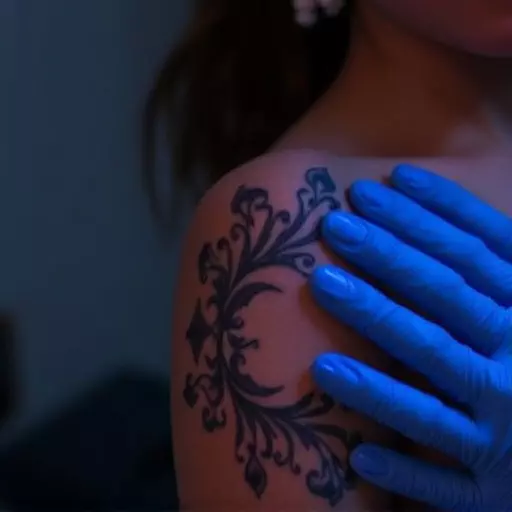Tattoo lightening in Toledo offers various methods—laser and non-laser—for reducing ink visibility. Non-laser options provide gentle, gradual fading over time, while laser lightening delivers quicker results for sensitive skin areas. Safety is crucial; consult professionals using sterile equipment and follow aftercare instructions. Proper post-treatment care ensures optimal results and minimizes risks, with patience required as complete erasure may take several sessions.
Tattoos have become a form of self-expression for many, but what happens when the ink no longer aligns with your preferences? Tattoo lightening offers a solution, especially for those with sensitive skin. This comprehensive guide explores the various aspects of tattoo fading, focusing on non-laser and laser techniques. We’ll delve into the safety considerations crucial for sensitive skin, provide aftercare tips, and set expectations regarding results. Whether you’re in Toledo or beyond, understanding the tattoo lightening process is key to making informed decisions about your ink.
- Understanding Tattoo Lightening: A Comprehensive Overview
- The Tattoo Lightening Process: Non-Laser vs. Laser Techniques
- Choosing the Right Method for Sensitive Skin
- Safety Precautions and Potential Side Effects
- Aftercare and Results Expectations
Understanding Tattoo Lightening: A Comprehensive Overview
Tattoo lightening is a procedure that aims to reduce the intensity and visibility of tattoos on sensitive skin areas. It’s a comprehensive process that involves breaking down the pigment particles in the tattoo ink, making them smaller and allowing the body to eliminate them more easily. This method is particularly sought after for those with delicate skin who wish to fade or remove tattoos without the potential risks associated with laser treatments.
There are two primary approaches to tattoo lightening: laser and non-laser methods. Laser tattoo lightening uses targeted beams of light to fragment the tattoo ink, allowing the body’s immune system to process and eliminate the resulting smaller particles. Non-laser alternatives, on the other hand, often employ topical creams or natural ingredients to gradually fade tattoos. These include chemical peels, microdermabrasion, and even at-home treatments with ingredients like lemon juice or apple cider vinegar. Each method has its advantages and considerations, catering to different skin types and tattoo fading goals.
The Tattoo Lightening Process: Non-Laser vs. Laser Techniques
The Tattoo Lightening Process involves a careful balance between removing pigment and preserving skin integrity, especially for those with sensitive skin in Toledo. Non-laser techniques often rely on topical creams or chemical treatments to fade tattoos gradually over several weeks. These methods are generally gentler on the skin but may require more time to achieve desired results. On the other hand, laser tattoo lightening targets specific pigment particles using high-intensity light to break them down. This procedure is faster but can be more intense, potentially causing side effects like temporary redness or peeling, especially with sensitive skin types.
Choosing between non-laser and laser methods depends on individual preferences, budget, and the desired speed of results. Laser treatments offer quicker fading, often in fewer sessions, while non-laser options are milder but might demand more persistence. Both have their merits, and professionals can guide individuals in making informed decisions tailored to their unique skin conditions.
Choosing the Right Method for Sensitive Skin
When it comes to tattoo lightening for sensitive skin, a tailored approach is essential. Many traditional methods like laser tattoo removal can be harsh and cause further irritation, making them unsuitable for those with delicate skin. The key lies in opting for gentler alternatives that avoid intense energy beams or chemicals that might aggravate the condition.
Consider non-laser tattoo lightening processes which utilize specialized creams, topical agents, or gentle exfoliation techniques to gradually fade the ink. These methods offer a safer bet for sensitive skin by minimizing potential side effects like redness, itching, or blistering. Consulting with a dermatologist who specializes in tattoo care is crucial to determine the most suitable non-laser or laser lightening options for your specific needs and skin type in the Toledo area.
Safety Precautions and Potential Side Effects
When considering tattoo lightening, especially for sensitive skin, safety should be your top priority. Both laser and non-laser tattoo lightening processes carry potential risks and side effects. With laser lightening, there’s a chance of skin irritation, blistering, and changes in skin pigmentation—uneven lightening or hyperpigmentation can occur, particularly in darker skin tones. Non-laser methods may also cause skin reactions, redness, swelling, and discomfort during the procedure.
It’s crucial to consult with a qualified professional who uses sterile equipment and follows hygienic practices to minimize these risks. They should provide detailed aftercare instructions to help your skin heal properly. Always be aware of any potential allergic reactions to creams or medications used in the lightening process. Remember, proper precautions can significantly reduce the chances of adverse effects, ensuring a safer tattoo lightening experience for sensitive skin.
Aftercare and Results Expectations
After getting tattoo lightening treatment, proper aftercare is essential for achieving optimal results and minimizing potential risks. Regardless of whether you opt for a laser tattoo lightening or non-laser approach (tattoo lightening process Toledo), your skin will be more sensitive post-procedure. It’s crucial to follow the recommendations provided by your specialist, which often includes keeping the treated area clean and moisturized, using gentle products, and avoiding direct sunlight until healing is complete.
Results can vary from person to person, depending on factors like skin type, tattoo age, ink color, and the method employed. With laser tattoo lightening, you may start seeing initial fading within a few sessions, with further improvements as treatment progresses. Non-laser methods typically offer more gradual results, but they are often effective in reducing tattoo intensity over time. Patience is key, as complete tattoo erasure can take several sessions spread across weeks or months.


